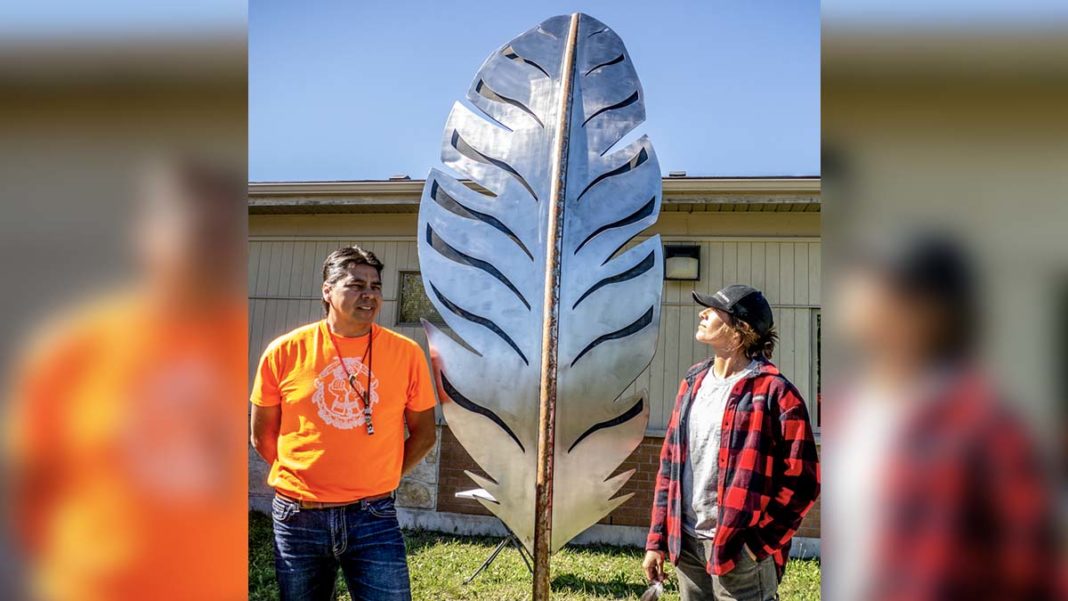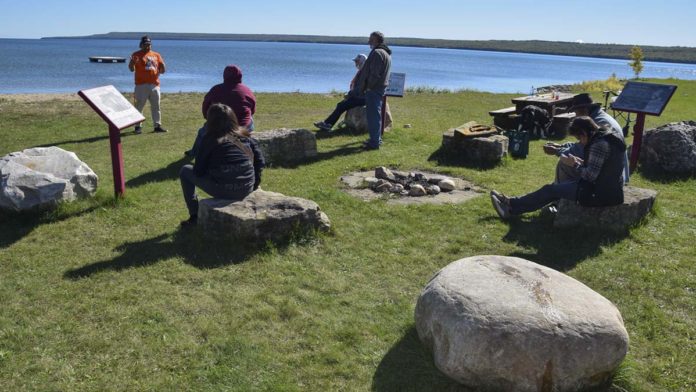by Isobel Harry
AUNDECK OMNI KANING—One of the best ways to begin to understand what is meant by and involved in the process of Reconciliation is to participate in events of the National Day for Truth and Reconciliation, held annually on September 30.
The Truth and Reconciliation Commission (TRC) was charged between 2008 and 2015 to listen to survivors, their families, communities and others affected by the system of federally-run residential schools that operated in Canada between 1867 and 1996, and to educate Canadians about these experiences. A federal statutory day of commemoration was instituted in 2021, arising from Call to Action number 80 of the TRC’s final report.
The day was marked last Thursday, September 29, by Mnaamodzawin Health Services and Noojmowin Teg Health Centre, two leading Indigenous organizations in cultural health practice, located in Aundeck Omni Kaning First Nation.
The day was bright and warm, conducive to holding the event outside in the summer-like conditions. Many in attendance wore the orange ‘Every Child Matters’ t-shirts that are now synonymous with the National Day, commemorating the children who never returned from the schools, hundreds buried secretly and unceremoniously in unmarked ground around the notorious institutions.
Craig Abotossaway, executive director of Mnaamodzawin and Danielle Wilson, executive director of Noojmowin Teg welcomed everyone present, acknowledging the TRC’s Call to Action that had brought about the National Day.
“We’re here because of our ancestors who are not here today,” said Mr. Abotossaway to the spectators standing respectfully and to the seated dignitaries. “Those are the spirits that are most important.” He reminded everyone that all these types of gatherings by Indigenous people were once banned—the drums, the songs, the ceremonies, the languages.
Sitting in a circle at the front of the building were the singers around the large drum; a smudge of sacred medicine herbs was passed around them and into the audience. A pipe ceremony was held as pipe carrier Eleanor Debassige, who has been the diabetes health promotion coordinator with Mnaamodzawin for 27 years, was invited to sit in with the group.
The distinctive heartbeat rhythm of the drum pulsed under the drumsticks as the voices soared in the ancient songs, never failing to invoke a feeling of reverence. Berries were passed to the drum group by Tracy Tooley, Mnaamodzawin’s operations manager.
Mr. Abotossaway explained that the pipe ceremonies “open the door to the spirit world. The missing children are here today; their graves were disturbed but they were never able to go home. They want to go home and our ceremonies are sending them home. The drums open the doorway, the songs honour the children who showed up today and acknowledge their journey. The spirits are present when we do ceremony.”
As more and more is revealed during the ceremonies, the meaning of this day becomes clear, unambiguous. “We want people to be aware, to understand what we do. It’s important in the decolonizing journey,” says Mr. Abotossaway. “First we acknowledge the spirits who were here before and are walking among us. Children showed up here today—they sacrificed their lives. We keep this day in mind to support the children who never made it home and the Survivors of residential schools.”
Elder and survivor Marion McGregor of Whitefish River First Nation is invited to share her experience; the woman in the beautiful ribbon skirt is offered a chair and the eagle feather to hold, signifying the truth of the speaker’s words. She speaks softly of being born to her mother who was 16 years old; how she was raised by her grandparents who had gone to residential school in Wiikwemkoong and were not allowed to go home; how Marion went to school only in spring and fall “because there were no snow plows” to clear the way; how she was flown to the school in Spanish.
“I can’t remember much about it,” says Ms. McGregor, “I tried to make the best of it.” She remembered working in the barns with the cows and jumping on the hay. “We could never speak of our homes, we were not allowed to speak our language. I was there for 10 years.” Ms. McGregor says she went to a couple of school reunions later and “learned from the Fire Keeper at one of them about the children who died and were not buried. He was helping them to pass over to the other side.”
At this point Mr. Abotossaway, as leader of the drum says that the spirits “asked for an honour song for the survivors who are still out there suffering. They asked to sit in with a drum honour song.” One of the singers, Ken Kakeeway of Whitefish Bay speaks: “There are a lot of survivors out there, they have sickness from the residential schools, they’re in hospitals, on the streets, in jails. We’re helping them today because no-one speaks for them.” Drummers Bryan Corbiere, Brett Abotossaway and Don Belleau join him and Craig.
It is time to unveil the sculpture commissioned for this day and artist metalworker Kathryn Corbiere is called up as an honour song acknowledges the Creator of the stunning stainless feather that stands about 10 feet tall pointing at the sky. A welder by trade for seven years, Ms. Corbiere has designed the feather’s core and back to show weathering and patina over time while the feathery aspect of the sculpture remains pristine stainless steel.
Other invited dignitaries said a few words, Al McNevin, Northeast Town mayor, Michael Mantha, Algoma-Manitoulin’s Member of Provincial Parliament and OPP Constable John Hill, the newest community services officer for Manitoulin Island, are then summoned to stand by the drum as their presence is honoured with a song.
At the end of the day, by the trays of sweets, pipe carrier Eleanor Debassige reveals to this writer the first vision she had last year: “I saw children standing around the building that day. I see them at ceremonies now, they are always in black and white, in their residential school clothes, in white shirts … It was the children who chose me to carry the pipe. I saw the children today…”
The warm weather is mirrored in the warm welcomes, heartfelt acknowledgements received, listening liberally extended, songs and food generously shared and gratefulness expressed on this Truth and Reconciliation Day. Teachings such as these are essential steps on the path of the truth that leads to reconciliation.





